标签:XA SQ 外连接 gif 间接 左连接 tran 名称 关于
#建表 create table department( id int, name varchar(20) ); create table employee( id int primary key auto_increment, name varchar(20), sex enum(‘male‘,‘female‘) not null default ‘male‘, age int, dep_id int ); #插入数据 insert into department values (200,‘技术‘), (201,‘人力资源‘), (202,‘销售‘), (203,‘运营‘); insert into employee(name,sex,age,dep_id) values (‘egon‘,‘male‘,18,200), (‘alex‘,‘female‘,48,201), (‘wupeiqi‘,‘male‘,38,201), (‘yuanhao‘,‘female‘,28,202), (‘liwenzhou‘,‘male‘,18,200), (‘jingliyang‘,‘female‘,18,204) ;
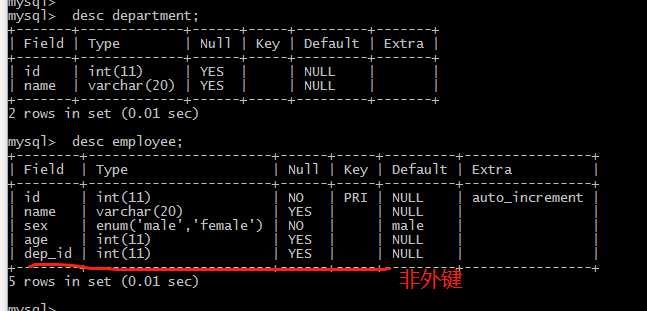
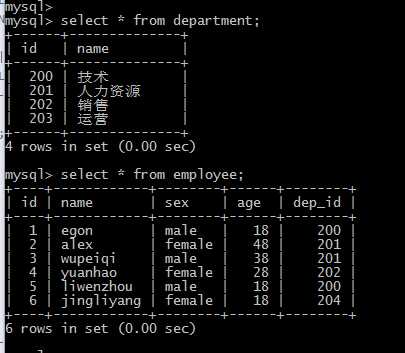
#重点:外链接语法 SELECT 字段列表 FROM 表1 INNER|LEFT|RIGHT JOIN 表2 ON 表1.字段 = 表2.字段;
select * from employee,department;
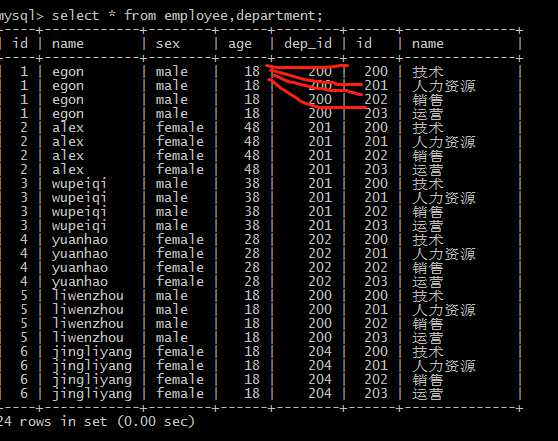
select * from employee inner join department on employee.dep_id = department.id ;

select * from employee left join department on employee.dep_id = department.id ;

select * from employee right join department on employee.dep_id = department.id ;

全外连接:在内连接的基础上增加左边有右边没有的和右边有左边没有的结果
#注意:mysql不支持全外连接 full JOIN select * from employee full join department on employee.dep_id = department.id ; #强调:mysql可以使用此种方式间接实现全外连接 select * from employee left join department on employee.dep_id = department.id union select * from employee right join department on employee.dep_id = department.id ; #注意 union与union all的区别:union会去掉相同的纪录


#示例1:以内连接的方式查询employee和department表,并且employee表中的age字段值必须大于25,即找出年龄大于25岁的员工以及员工所在的部门 select employee.name,department.name from employee inner join department on employee.dep_id = department.id where age > 25; #示例2:以内连接的方式查询employee和department表,并且以age字段的升序方式显示 select employee.id,employee.name,employee.age,department.name from employee,department where employee.dep_id = department.id and age > 25 order by age asc;
#1:子查询是将一个查询语句嵌套在另一个查询语句中。 #2:内层查询语句的查询结果,可以为外层查询语句提供查询条件。 #3:子查询中可以包含:IN、NOT IN、ANY、ALL、EXISTS 和 NOT EXISTS等关键字 #4:还可以包含比较运算符:= 、 !=、> 、<等
#查询平均年龄在25岁以上的部门名 select id,name from department where id in (select dep_id from employee group by dep_id having avg(age) > 25); #查看技术部员工姓名 select name from employee where dep_id in (select id from department where name=‘技术‘); #查看不足1人的部门名 select name from department where id in (select dep_id from employee group by dep_id having count(id) <=1);



#比较运算符:=、!=、>、>=、<、<=、<>
#查询大于所有人平均年龄的员工名与年龄 select name,age from emp where age > (select avg(age) from emp); #查询大于部门内平均年龄的员工名、年龄 select t1.name,t1.age from emp t1 inner join (select dep_id,avg(age) avg_age from emp group by dep_id) t2 on t1.dep_id = t2.dep_id where t1.age > t2.avg_age;
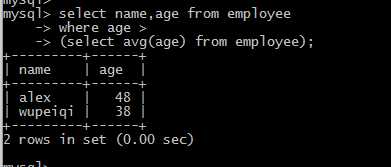

EXISTS关字键字表示存在。
在使用EXISTS关键字时,内层查询语句不返回查询的记录。而是返回一个真假值。True或False
当返回True时,外层查询语句将进行查询;
当返回值为False时,外层查询语句不进行查询
#department表中存在dept_id=203,Ture mysql> select * from employee -> where exists -> (select id from department where id=200); +----+------------+--------+------+--------+ | id | name | sex | age | dep_id | +----+------------+--------+------+--------+ | 1 | egon | male | 18 | 200 | | 2 | alex | female | 48 | 201 | | 3 | wupeiqi | male | 38 | 201 | | 4 | yuanhao | female | 28 | 202 | | 5 | liwenzhou | male | 18 | 200 | | 6 | jingliyang | female | 18 | 204 | +----+------------+--------+------+--------+ #department表中存在dept_id=205,False mysql> select * from employee -> where exists -> (select id from department where id=204); Empty set (0.00 sec)
http://www.cnblogs.com/linhaifeng/articles/7372774.html
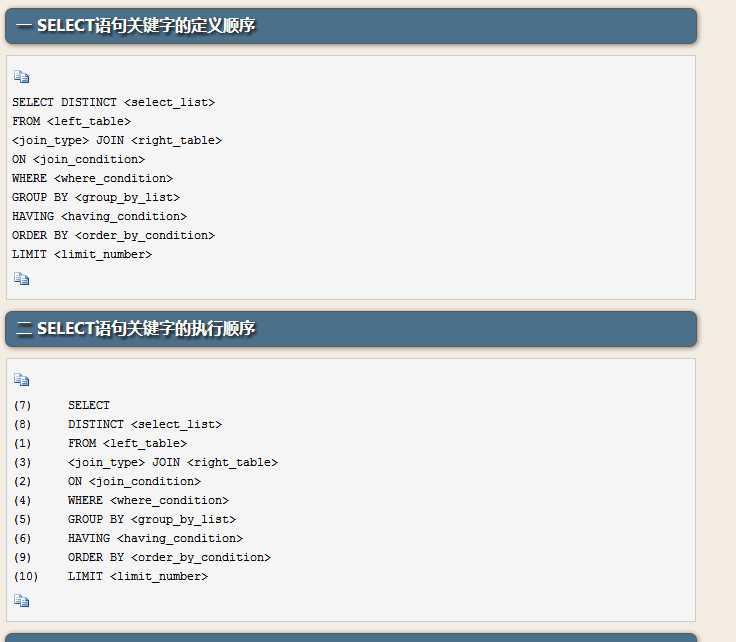
# 虚拟表 在这些SQL语句的执行过程中,都会产生一个虚拟表,用来保存SQL语句的执行结果(这是重点),我现在就来跟踪这个虚拟表的变化,得到最终的查询结果的过程,来分析整个SQL逻辑查询的执行顺序和过程。
虚拟表
#查询来自杭州,并且订单数少于2的客户。 select a.customer_id, count(b.order_id) as total_orders from table1 as a left join table2 as b on a.customer_id = b.customer_id where a.city = ‘hangzhou‘ group by a.customer_id having count(b.order_id) < 2 order by total_orders desc limit 1;

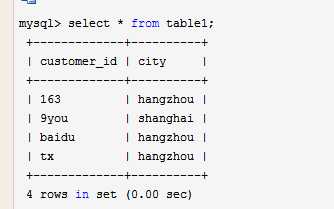
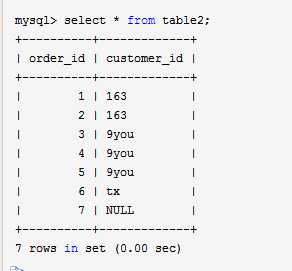
(1)执行FROM语句
第一步,执行FROM语句。我们首先需要知道最开始从哪个表开始的,这就是FROM告诉我们的。现在有了<left_table>和<right_table>两个表,我们到底从哪个表开始,还是从两个表进行某种联系以后再开始呢?它们之间如何产生联系呢?——笛卡尔积
关于什么是笛卡尔积,请自行Google补脑。经过FROM语句对两个表执行笛卡尔积,会得到一个虚拟表,暂且叫VT1(vitual table 1),内容如下:
总共有28(table1的记录条数 * table2的记录条数)条记录。这就是VT1的结果,接下来的操作就在VT1的基础上进行。
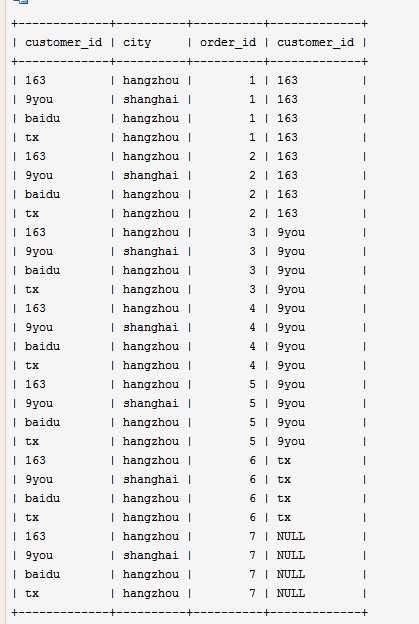
(2)执行ON过滤
执行完笛卡尔积以后,接着就进行ON a.customer_id = b.customer_id条件过滤,根据ON中指定的条件,去掉那些不符合条件的数据,得到VT2表,内容如下:
VT2就是经过ON条件筛选以后得到的有用数据,而接下来的操作将在VT2的基础上继续进行。
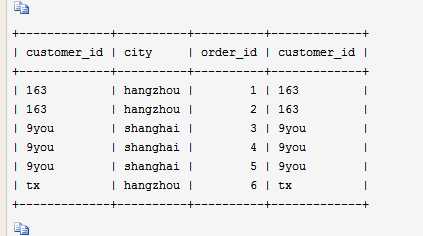
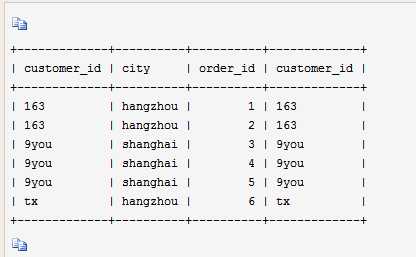
(3)添加外部行
这一步只有在连接类型为OUTER JOIN时才发生,如LEFT OUTER JOIN、RIGHT OUTER JOIN和FULL OUTER JOIN。在大多数的时候,我们都是会省略掉OUTER关键字的,但OUTER表示的就是外部行的概念。
LEFT OUTER JOIN把左表记为保留表,得到的结果为:
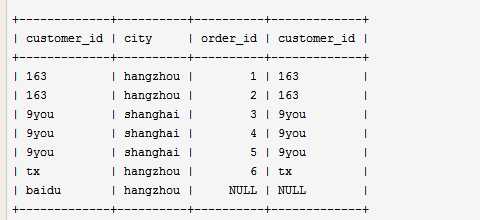
添加外部行的工作就是在VT2表的基础上添加保留表中被过滤条件过滤掉的数据,非保留表中的数据被赋予NULL值,最后生成虚拟表VT3。
由于我在准备的测试SQL查询逻辑语句中使用的是LEFT JOIN,过滤掉了以下这条数据:
| baidu | hangzhou | NULL | NULL |
现在就把这条数据添加到VT2表中,得到的VT3表如下:

(4)执行WHERE过滤
(5)执行GROUP BY分组
(6)执行HAVING过滤
(7)SELECT列表
现在才会执行到SELECT子句,不要以为SELECT子句被写在第一行,就是第一个被执行的。
我们执行测试语句中的SELECT a.customer_id, COUNT(b.order_id) as total_orders,从虚拟表VT6中选择出我们需要的内容。我们将得到以下内容:
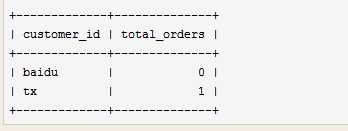
(8)执行DISTINCT子句
(9)执行ORDER BY子句
(10)执行LIMIT子句
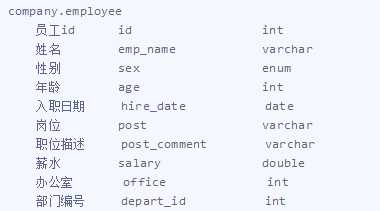

#创建表 create table employee( id int not null unique auto_increment, name varchar(20) not null, sex enum(‘male‘,‘female‘) not null default ‘male‘, #大部分是男的 age int(3) unsigned not null default 28, hire_date date not null, post varchar(50), post_comment varchar(100), salary double(15,2), office int, #一个部门一个屋子 depart_id int ); #插入记录 #三个部门:教学,销售,运营 insert into employee(name,sex,age,hire_date,post,salary,office,depart_id) values (‘egon‘,‘male‘,18,‘20170301‘,‘老男孩驻沙河办事处外交大使‘,7300.33,401,1), #以下是教学部 (‘alex‘,‘male‘,78,‘20150302‘,‘teacher‘,1000000.31,401,1), (‘wupeiqi‘,‘male‘,81,‘20130305‘,‘teacher‘,8300,401,1), (‘yuanhao‘,‘male‘,73,‘20140701‘,‘teacher‘,3500,401,1), (‘liwenzhou‘,‘male‘,28,‘20121101‘,‘teacher‘,2100,401,1), (‘jingliyang‘,‘female‘,18,‘20110211‘,‘teacher‘,9000,401,1), (‘jinxin‘,‘male‘,18,‘19000301‘,‘teacher‘,30000,401,1), (‘成龙‘,‘male‘,48,‘20101111‘,‘teacher‘,10000,401,1), (‘歪歪‘,‘female‘,48,‘20150311‘,‘sale‘,3000.13,402,2),#以下是销售部门 (‘丫丫‘,‘female‘,38,‘20101101‘,‘sale‘,2000.35,402,2), (‘丁丁‘,‘female‘,18,‘20110312‘,‘sale‘,1000.37,402,2), (‘星星‘,‘female‘,18,‘20160513‘,‘sale‘,3000.29,402,2), (‘格格‘,‘female‘,28,‘20170127‘,‘sale‘,4000.33,402,2), (‘张野‘,‘male‘,28,‘20160311‘,‘operation‘,10000.13,403,3), #以下是运营部门 (‘程咬金‘,‘male‘,18,‘19970312‘,‘operation‘,20000,403,3), (‘程咬银‘,‘female‘,18,‘20130311‘,‘operation‘,19000,403,3), (‘程咬铜‘,‘male‘,18,‘20150411‘,‘operation‘,18000,403,3), (‘程咬铁‘,‘female‘,18,‘20140512‘,‘operation‘,17000,403,3) ; #ps:如果在windows系统中,插入中文字符,select的结果为空白,可以将所有字符编码统一设置成gbk
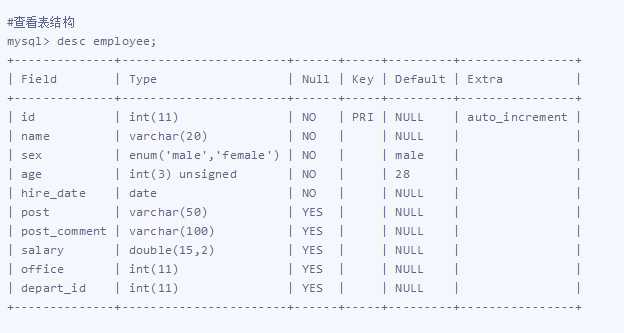

#查询每个部门最新入职的那位员工 select post,max(hire_date) from employee group by post; select * from employee as t1 inner join (select post,max(hire_date) from employee group by post) as t2 on t1.post=t2.post where t1.hire_date=t2.hire_date; select * from employee as t1 inner join (select post,max(hire_date) as max_hire_date from employee group by post) as t2 on t1.post=t2.post where t1.hire_date=t2.max_hire_date;

SELECT * FROM emp AS t1 INNER JOIN ( SELECT post, max(hire_date) max_date FROM emp GROUP BY post ) AS t2 ON t1.post = t2.post WHERE t1.hire_date = t2.max_date; 答案一(链表) mysql> select (select t2.name from emp as t2 where t2.post=t1.post order by hire_date desc limit 1) from emp as t1 group by post; +---------------------------------------------------------------------------------------+ | (select t2.name from emp as t2 where t2.post=t1.post order by hire_date desc limit 1) | +---------------------------------------------------------------------------------------+ | 张野 | | 格格 | | alex | | egon | +---------------------------------------------------------------------------------------+ rows in set (0.00 sec) mysql> select (select t2.id from emp as t2 where t2.post=t1.post order by hire_date desc limit 1) from emp as t1 group by post; +-------------------------------------------------------------------------------------+ | (select t2.id from emp as t2 where t2.post=t1.post order by hire_date desc limit 1) | +-------------------------------------------------------------------------------------+ | 14 | | 13 | | 2 | | 1 | +-------------------------------------------------------------------------------------+ rows in set (0.00 sec) #正确答案 mysql> select t3.name,t3.post,t3.hire_date from emp as t3 where id in (select (select id from emp as t2 where t2.post=t1.post order by hire_date desc limit 1) from emp as t1 group by post); +--------+-----------------------------------------+------------+ | name | post | hire_date | +--------+-----------------------------------------+------------+ | egon | 老男孩驻沙河办事处外交大使 | 2017-03-01 | | alex | teacher | 2015-03-02 | | 格格 | sale | 2017-01-27 | | 张野 | operation | 2016-03-11 | +--------+-----------------------------------------+------------+ rows in set (0.00 sec) 答案二(子查询)

答案一为正确答案,答案二中的limit 1有问题(每个部门可能有>1个为同一时间入职的新员工),我只是想用该例子来说明可以在select后使用子查询
可以基于上述方法解决:比如某网站在全国各个市都有站点,每个站点一条数据,想取每个省下最新的那一条市的网站质量信息
init.sql文件内容

/* 数据导入: Navicat Premium Data Transfer Source Server : localhost Source Server Type : MySQL Source Server Version : 50624 Source Host : localhost Source Database : sqlexam Target Server Type : MySQL Target Server Version : 50624 File Encoding : utf-8 Date: 10/21/2016 06:46:46 AM */ SET NAMES utf8; SET FOREIGN_KEY_CHECKS = 0; -- ---------------------------- -- Table structure for `class` -- ---------------------------- DROP TABLE IF EXISTS `class`; CREATE TABLE `class` ( `cid` int(11) NOT NULL AUTO_INCREMENT, `caption` varchar(32) NOT NULL, PRIMARY KEY (`cid`) ) ENGINE=InnoDB AUTO_INCREMENT=5 DEFAULT CHARSET=utf8; -- ---------------------------- -- Records of `class` -- ---------------------------- BEGIN; INSERT INTO `class` VALUES (‘1‘, ‘三年二班‘), (‘2‘, ‘三年三班‘), (‘3‘, ‘一年二班‘), (‘4‘, ‘二年九班‘); COMMIT; -- ---------------------------- -- Table structure for `course` -- ---------------------------- DROP TABLE IF EXISTS `course`; CREATE TABLE `course` ( `cid` int(11) NOT NULL AUTO_INCREMENT, `cname` varchar(32) NOT NULL, `teacher_id` int(11) NOT NULL, PRIMARY KEY (`cid`), KEY `fk_course_teacher` (`teacher_id`), CONSTRAINT `fk_course_teacher` FOREIGN KEY (`teacher_id`) REFERENCES `teacher` (`tid`) ) ENGINE=InnoDB AUTO_INCREMENT=5 DEFAULT CHARSET=utf8; -- ---------------------------- -- Records of `course` -- ---------------------------- BEGIN; INSERT INTO `course` VALUES (‘1‘, ‘生物‘, ‘1‘), (‘2‘, ‘物理‘, ‘2‘), (‘3‘, ‘体育‘, ‘3‘), (‘4‘, ‘美术‘, ‘2‘); COMMIT; -- ---------------------------- -- Table structure for `score` -- ---------------------------- DROP TABLE IF EXISTS `score`; CREATE TABLE `score` ( `sid` int(11) NOT NULL AUTO_INCREMENT, `student_id` int(11) NOT NULL, `course_id` int(11) NOT NULL, `num` int(11) NOT NULL, PRIMARY KEY (`sid`), KEY `fk_score_student` (`student_id`), KEY `fk_score_course` (`course_id`), CONSTRAINT `fk_score_course` FOREIGN KEY (`course_id`) REFERENCES `course` (`cid`), CONSTRAINT `fk_score_student` FOREIGN KEY (`student_id`) REFERENCES `student` (`sid`) ) ENGINE=InnoDB AUTO_INCREMENT=53 DEFAULT CHARSET=utf8; -- ---------------------------- -- Records of `score` -- ---------------------------- BEGIN; INSERT INTO `score` VALUES (‘1‘, ‘1‘, ‘1‘, ‘10‘), (‘2‘, ‘1‘, ‘2‘, ‘9‘), (‘5‘, ‘1‘, ‘4‘, ‘66‘), (‘6‘, ‘2‘, ‘1‘, ‘8‘), (‘8‘, ‘2‘, ‘3‘, ‘68‘), (‘9‘, ‘2‘, ‘4‘, ‘99‘), (‘10‘, ‘3‘, ‘1‘, ‘77‘), (‘11‘, ‘3‘, ‘2‘, ‘66‘), (‘12‘, ‘3‘, ‘3‘, ‘87‘), (‘13‘, ‘3‘, ‘4‘, ‘99‘), (‘14‘, ‘4‘, ‘1‘, ‘79‘), (‘15‘, ‘4‘, ‘2‘, ‘11‘), (‘16‘, ‘4‘, ‘3‘, ‘67‘), (‘17‘, ‘4‘, ‘4‘, ‘100‘), (‘18‘, ‘5‘, ‘1‘, ‘79‘), (‘19‘, ‘5‘, ‘2‘, ‘11‘), (‘20‘, ‘5‘, ‘3‘, ‘67‘), (‘21‘, ‘5‘, ‘4‘, ‘100‘), (‘22‘, ‘6‘, ‘1‘, ‘9‘), (‘23‘, ‘6‘, ‘2‘, ‘100‘), (‘24‘, ‘6‘, ‘3‘, ‘67‘), (‘25‘, ‘6‘, ‘4‘, ‘100‘), (‘26‘, ‘7‘, ‘1‘, ‘9‘), (‘27‘, ‘7‘, ‘2‘, ‘100‘), (‘28‘, ‘7‘, ‘3‘, ‘67‘), (‘29‘, ‘7‘, ‘4‘, ‘88‘), (‘30‘, ‘8‘, ‘1‘, ‘9‘), (‘31‘, ‘8‘, ‘2‘, ‘100‘), (‘32‘, ‘8‘, ‘3‘, ‘67‘), (‘33‘, ‘8‘, ‘4‘, ‘88‘), (‘34‘, ‘9‘, ‘1‘, ‘91‘), (‘35‘, ‘9‘, ‘2‘, ‘88‘), (‘36‘, ‘9‘, ‘3‘, ‘67‘), (‘37‘, ‘9‘, ‘4‘, ‘22‘), (‘38‘, ‘10‘, ‘1‘, ‘90‘), (‘39‘, ‘10‘, ‘2‘, ‘77‘), (‘40‘, ‘10‘, ‘3‘, ‘43‘), (‘41‘, ‘10‘, ‘4‘, ‘87‘), (‘42‘, ‘11‘, ‘1‘, ‘90‘), (‘43‘, ‘11‘, ‘2‘, ‘77‘), (‘44‘, ‘11‘, ‘3‘, ‘43‘), (‘45‘, ‘11‘, ‘4‘, ‘87‘), (‘46‘, ‘12‘, ‘1‘, ‘90‘), (‘47‘, ‘12‘, ‘2‘, ‘77‘), (‘48‘, ‘12‘, ‘3‘, ‘43‘), (‘49‘, ‘12‘, ‘4‘, ‘87‘), (‘52‘, ‘13‘, ‘3‘, ‘87‘); COMMIT; -- ---------------------------- -- Table structure for `student` -- ---------------------------- DROP TABLE IF EXISTS `student`; CREATE TABLE `student` ( `sid` int(11) NOT NULL AUTO_INCREMENT, `gender` char(1) NOT NULL, `class_id` int(11) NOT NULL, `sname` varchar(32) NOT NULL, PRIMARY KEY (`sid`), KEY `fk_class` (`class_id`), CONSTRAINT `fk_class` FOREIGN KEY (`class_id`) REFERENCES `class` (`cid`) ) ENGINE=InnoDB AUTO_INCREMENT=17 DEFAULT CHARSET=utf8; -- ---------------------------- -- Records of `student` -- ---------------------------- BEGIN; INSERT INTO `student` VALUES (‘1‘, ‘男‘, ‘1‘, ‘理解‘), (‘2‘, ‘女‘, ‘1‘, ‘钢蛋‘), (‘3‘, ‘男‘, ‘1‘, ‘张三‘), (‘4‘, ‘男‘, ‘1‘, ‘张一‘), (‘5‘, ‘女‘, ‘1‘, ‘张二‘), (‘6‘, ‘男‘, ‘1‘, ‘张四‘), (‘7‘, ‘女‘, ‘2‘, ‘铁锤‘), (‘8‘, ‘男‘, ‘2‘, ‘李三‘), (‘9‘, ‘男‘, ‘2‘, ‘李一‘), (‘10‘, ‘女‘, ‘2‘, ‘李二‘), (‘11‘, ‘男‘, ‘2‘, ‘李四‘), (‘12‘, ‘女‘, ‘3‘, ‘如花‘), (‘13‘, ‘男‘, ‘3‘, ‘刘三‘), (‘14‘, ‘男‘, ‘3‘, ‘刘一‘), (‘15‘, ‘女‘, ‘3‘, ‘刘二‘), (‘16‘, ‘男‘, ‘3‘, ‘刘四‘); COMMIT; -- ---------------------------- -- Table structure for `teacher` -- ---------------------------- DROP TABLE IF EXISTS `teacher`; CREATE TABLE `teacher` ( `tid` int(11) NOT NULL AUTO_INCREMENT, `tname` varchar(32) NOT NULL, PRIMARY KEY (`tid`) ) ENGINE=InnoDB AUTO_INCREMENT=6 DEFAULT CHARSET=utf8; -- ---------------------------- -- Records of `teacher` -- ---------------------------- BEGIN; INSERT INTO `teacher` VALUES (‘1‘, ‘张磊老师‘), (‘2‘, ‘李平老师‘), (‘3‘, ‘刘海燕老师‘), (‘4‘, ‘朱云海老师‘), (‘5‘, ‘李杰老师‘); COMMIT; SET FOREIGN_KEY_CHECKS = 1;
从init.sql文件中导入数据 #准备表、记录 mysql> create database db1; mysql> use db1; mysql> source /root/init.sql
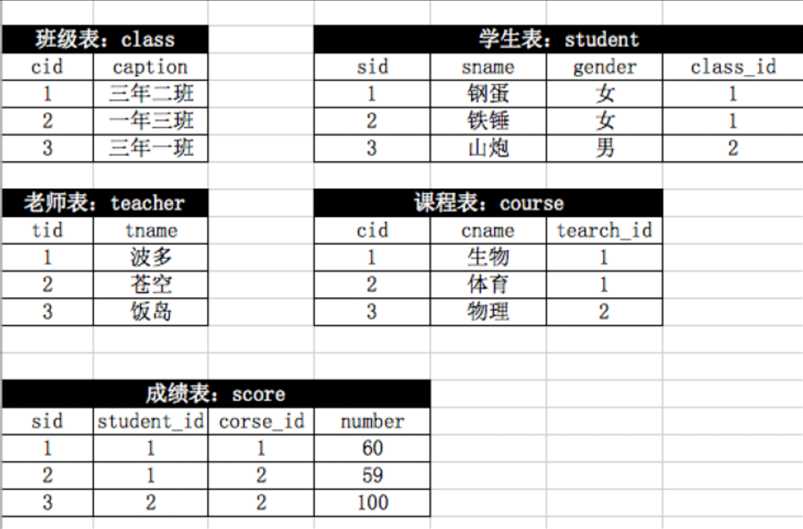
1、查询所有的课程的名称以及对应的任课老师姓名 2、查询学生表中男女生各有多少人 3、查询物理成绩等于100的学生的姓名 4、查询平均成绩大于八十分的同学的姓名和平均成绩 5、查询所有学生的学号,姓名,选课数,总成绩 6、 查询姓李老师的个数 7、 查询没有报李平老师课的学生姓名 8、 查询物理课程比生物课程高的学生的学号 9、 查询没有同时选修物理课程和体育课程的学生姓名 10、查询挂科超过两门(包括两门)的学生姓名和班级 、查询选修了所有课程的学生姓名 12、查询李平老师教的课程的所有成绩记录 13、查询全部学生都选修了的课程号和课程名 14、查询每门课程被选修的次数 15、查询之选修了一门课程的学生姓名和学号 16、查询所有学生考出的成绩并按从高到低排序(成绩去重) 17、查询平均成绩大于85的学生姓名和平均成绩 18、查询生物成绩不及格的学生姓名和对应生物分数 19、查询在所有选修了李平老师课程的学生中,这些课程(李平老师的课程,不是所有课程)平均成绩最高的学生姓名 20、查询每门课程成绩最好的前两名学生姓名 21、查询不同课程但成绩相同的学号,课程号,成绩 22、查询没学过“叶平”老师课程的学生姓名以及选修的课程名称; 23、查询所有选修了学号为1的同学选修过的一门或者多门课程的同学学号和姓名; 24、任课最多的老师中学生单科成绩最高的学生姓名 题目

#1、查询所有的课程的名称以及对应的任课老师姓名 SELECT course.cname, teacher.tname FROM course INNER JOIN teacher ON course.teacher_id = teacher.tid; #2、查询学生表中男女生各有多少人 SELECT gender 性别, count(1) 人数 FROM student GROUP BY gender; #3、查询物理成绩等于100的学生的姓名 SELECT student.sname FROM student WHERE sid IN ( SELECT student_id FROM score INNER JOIN course ON score.course_id = course.cid WHERE course.cname = ‘物理‘ AND score.num = 100 ); #4、查询平均成绩大于八十分的同学的姓名和平均成绩 SELECT student.sname, t1.avg_num FROM student INNER JOIN ( SELECT student_id, avg(num) AS avg_num FROM score GROUP BY student_id HAVING avg(num) > 80 ) AS t1 ON student.sid = t1.student_id; #5、查询所有学生的学号,姓名,选课数,总成绩(注意:对于那些没有选修任何课程的学生也算在内) SELECT student.sid, student.sname, t1.course_num, t1.total_num FROM student LEFT JOIN ( SELECT student_id, COUNT(course_id) course_num, sum(num) total_num FROM score GROUP BY student_id ) AS t1 ON student.sid = t1.student_id; #6、 查询姓李老师的个数 SELECT count(tid) FROM teacher WHERE tname LIKE ‘李%‘; #7、 查询没有报李平老师课的学生姓名(找出报名李平老师课程的学生,然后取反就可以) SELECT student.sname FROM student WHERE sid NOT IN ( SELECT DISTINCT student_id FROM score WHERE course_id IN ( SELECT course.cid FROM course INNER JOIN teacher ON course.teacher_id = teacher.tid WHERE teacher.tname = ‘李平老师‘ ) ); #8、 查询物理课程比生物课程高的学生的学号(分别得到物理成绩表与生物成绩表,然后连表即可) SELECT t1.student_id FROM ( SELECT student_id, num FROM score WHERE course_id = ( SELECT cid FROM course WHERE cname = ‘物理‘ ) ) AS t1 INNER JOIN ( SELECT student_id, num FROM score WHERE course_id = ( SELECT cid FROM course WHERE cname = ‘生物‘ ) ) AS t2 ON t1.student_id = t2.student_id WHERE t1.num > t2.num; #9、 查询没有同时选修物理课程和体育课程的学生姓名(没有同时选修指的是选修了一门的,思路是得到物理+体育课程的学生信息表,然后基于学生分组,统计count(课程)=1) SELECT student.sname FROM student WHERE sid IN ( SELECT student_id FROM score WHERE course_id IN ( SELECT cid FROM course WHERE cname = ‘物理‘ OR cname = ‘体育‘ ) GROUP BY student_id HAVING COUNT(course_id) = 1 ); #10、查询挂科超过两门(包括两门)的学生姓名和班级(求出<60的表,然后对学生进行分组,统计课程数目>=2) SELECT student.sname, class.caption FROM student INNER JOIN ( SELECT student_id FROM score WHERE num < 60 GROUP BY student_id HAVING count(course_id) >= 2 ) AS t1 INNER JOIN class ON student.sid = t1.student_id AND student.class_id = class.cid; #11、查询选修了所有课程的学生姓名(先从course表统计课程的总数,然后基于score表按照student_id分组,统计课程数据等于课程总数即可) SELECT student.sname FROM student WHERE sid IN ( SELECT student_id FROM score GROUP BY student_id HAVING COUNT(course_id) = (SELECT count(cid) FROM course) ); #12、查询李平老师教的课程的所有成绩记录 SELECT * FROM score WHERE course_id IN ( SELECT cid FROM course INNER JOIN teacher ON course.teacher_id = teacher.tid WHERE teacher.tname = ‘李平老师‘ ); #13、查询全部学生都选修了的课程号和课程名(取所有学生数,然后基于score表的课程分组,找出count(student_id)等于学生数即可) SELECT cid, cname FROM course WHERE cid IN ( SELECT course_id FROM score GROUP BY course_id HAVING COUNT(student_id) = ( SELECT COUNT(sid) FROM student ) ); #14、查询每门课程被选修的次数 SELECT course_id, COUNT(student_id) FROM score GROUP BY course_id; #15、查询之选修了一门课程的学生姓名和学号 SELECT sid, sname FROM student WHERE sid IN ( SELECT student_id FROM score GROUP BY student_id HAVING COUNT(course_id) = 1 ); #16、查询所有学生考出的成绩并按从高到低排序(成绩去重) SELECT DISTINCT num FROM score ORDER BY num DESC; #17、查询平均成绩大于85的学生姓名和平均成绩 SELECT sname, t1.avg_num FROM student INNER JOIN ( SELECT student_id, avg(num) avg_num FROM score GROUP BY student_id HAVING AVG(num) > 85 ) t1 ON student.sid = t1.student_id; #18、查询生物成绩不及格的学生姓名和对应生物分数 SELECT sname 姓名, num 生物成绩 FROM score LEFT JOIN course ON score.course_id = course.cid LEFT JOIN student ON score.student_id = student.sid WHERE course.cname = ‘生物‘ AND score.num < 60; #19、查询在所有选修了李平老师课程的学生中,这些课程(李平老师的课程,不是所有课程)平均成绩最高的学生姓名 SELECT sname FROM student WHERE sid = ( SELECT student_id FROM score WHERE course_id IN ( SELECT course.cid FROM course INNER JOIN teacher ON course.teacher_id = teacher.tid WHERE teacher.tname = ‘李平老师‘ ) GROUP BY student_id ORDER BY AVG(num) DESC LIMIT 1 ); #20、查询每门课程成绩最好的前两名学生姓名 #查看每门课程按照分数排序的信息,为下列查找正确与否提供依据 SELECT * FROM score ORDER BY course_id, num DESC; #表1:求出每门课程的课程course_id,与最高分数first_num SELECT course_id, max(num) first_num FROM score GROUP BY course_id; #表2:去掉最高分,再按照课程分组,取得的最高分,就是第二高的分数second_num SELECT score.course_id, max(num) second_num FROM score INNER JOIN ( SELECT course_id, max(num) first_num FROM score GROUP BY course_id ) AS t ON score.course_id = t.course_id WHERE score.num < t.first_num GROUP BY course_id; #将表1和表2联合到一起,得到一张表t3,包含课程course_id与该们课程的first_num与second_num SELECT t1.course_id, t1.first_num, t2.second_num FROM ( SELECT course_id, max(num) first_num FROM score GROUP BY course_id ) AS t1 INNER JOIN ( SELECT score.course_id, max(num) second_num FROM score INNER JOIN ( SELECT course_id, max(num) first_num FROM score GROUP BY course_id ) AS t ON score.course_id = t.course_id WHERE score.num < t.first_num GROUP BY course_id ) AS t2 ON t1.course_id = t2.course_id; #查询前两名的学生(有可能出现并列第一或者并列第二的情况) SELECT score.student_id, t3.course_id, t3.first_num, t3.second_num FROM score INNER JOIN ( SELECT t1.course_id, t1.first_num, t2.second_num FROM ( SELECT course_id, max(num) first_num FROM score GROUP BY course_id ) AS t1 INNER JOIN ( SELECT score.course_id, max(num) second_num FROM score INNER JOIN ( SELECT course_id, max(num) first_num FROM score GROUP BY course_id ) AS t ON score.course_id = t.course_id WHERE score.num < t.first_num GROUP BY course_id ) AS t2 ON t1.course_id = t2.course_id ) AS t3 ON score.course_id = t3.course_id WHERE score.num >= t3.second_num AND score.num <= t3.first_num; #排序后可以看的明显点 SELECT score.student_id, t3.course_id, t3.first_num, t3.second_num FROM score INNER JOIN ( SELECT t1.course_id, t1.first_num, t2.second_num FROM ( SELECT course_id, max(num) first_num FROM score GROUP BY course_id ) AS t1 INNER JOIN ( SELECT score.course_id, max(num) second_num FROM score INNER JOIN ( SELECT course_id, max(num) first_num FROM score GROUP BY course_id ) AS t ON score.course_id = t.course_id WHERE score.num < t.first_num GROUP BY course_id ) AS t2 ON t1.course_id = t2.course_id ) AS t3 ON score.course_id = t3.course_id WHERE score.num >= t3.second_num AND score.num <= t3.first_num ORDER BY course_id; #可以用以下命令验证上述查询的正确性 SELECT * FROM score ORDER BY course_id, num DESC; -- 21、查询不同课程但成绩相同的学号,课程号,成绩 -- 22、查询没学过“叶平”老师课程的学生姓名以及选修的课程名称; -- 23、查询所有选修了学号为1的同学选修过的一门或者多门课程的同学学号和姓名; -- 24、任课最多的老师中学生单科成绩最高的学生姓名
标签:XA SQ 外连接 gif 间接 左连接 tran 名称 关于
原文地址:https://www.cnblogs.com/venicid/p/9031712.html